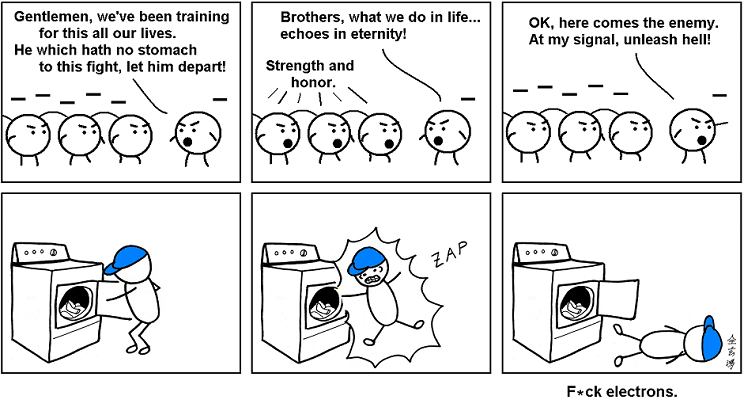 Some atoms, like the ones on the skin of your hand, are happy to give up their electrons. And the electrons congregate in some mysterious way, as AG says, into a band of brothers. The band is relentlessly negative, so when you get near enough to something positive, like a dryer or a doorknob, the band leaps toward it in a flash of tiny lightning. It really is the same as lightning, just smaller — for which we can all be grateful.
Some atoms, like the ones on the skin of your hand, are happy to give up their electrons. And the electrons congregate in some mysterious way, as AG says, into a band of brothers. The band is relentlessly negative, so when you get near enough to something positive, like a dryer or a doorknob, the band leaps toward it in a flash of tiny lightning. It really is the same as lightning, just smaller — for which we can all be grateful.
Also we can be grateful the electricity is static. Imagine if it were dynamic, like in an electric wire, and just kept coming.
Credit: http://abstrusegoose.com/324
As you know, I’m a dabbler in physics, intrigued by how those electrons behave and what’s going on in the spaces in between them, etc etc. I think I intuitively grasp some of the concepts – but the one that constantly eludes me, and which AG and you allude to, is ‘charge’. What’s the difference between a positively and negatively charged particle? Is it something to do with spin? Or what?
You can write your next book about this, if you like… (only kidding).
Dear Tim,
How am I supposed to know these things? My husband the physicist: (he sighs, long pause) “It’s just a property intrinsic to the particle. And ‘positive’ and ‘negative’ is arbitrary. Nobody knows what charge is.” Me: “Like gravity is just a property intrinsic to mass? Mass behaves a certain way, you don’t know why, and you call it gravitating?” MHtP: “Yes. Like that.”
Big help, isn’t he.
Ann
Good, it’s not just me then.